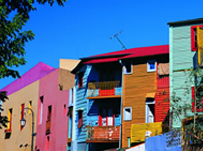Where’s the best place to learn Spanish in Latin America?
Sunday, 19th December 2010

Alex Wolfson, Latin America specialist at Cactus, ponders an inherently difficult question
Every day the Cactus Language Team receives many phone calls from our clients and potential clients. Most already know where they would like to take a language course because of a particular affection for a city, the desire to visit a specific place and combine it with language learning, because it’s cheaper to fly to or because of a romantic interest! However, the phone calls we enjoy most are from clients who know they want to take a language course but don’t necessarily know where. They seek our advice as to what’s best for them, and this is where we really get to show off our excellent product knowledge and recount stories of our own language courses and travels.
As the Latin America specialist I’ve been asked several times, “Where is the best place for me to take a Spanish language course?”. Of course this is near impossible to answer because of personal preferences about city size, levels of tourism, location, other attractions in the nearby area, etc. However, there are certain common factors in choosing a place to study a language, and I am going to use them to try to find my recommended top location for taking a language course.
Location does seem to be people’s top priority. As this is so subjective, according to individual interests, I won’t give one answer for this but instead my three personal preferences in the 4 following categories:
Types of Location
1. City: If you like city life and want a place with lots of people, plenty of culture, good public transport, food and great nightlife, it’s hard to look beyond Buenos Aires, the most cosmopolitan city on the continent with an atmosphere that oozes cool and provides a fascinating fusion of European and South American culture. The real up-and-coming city though is Bogotá. Gradually shedding its reputation for violence (in fact it has been as safe as any other city for many years) and gaining a reputation for experimental cuisine, it provides fantastic modern Latin music and culture as well as amazing museums where you can learn about the country’s pre-Columbian and colonial history as well as the legend of Eldorado. For sheer Latin American supercity craziness you can try Mexico City. Incredible nightlife and a huge population mean you won’t be bored and there’s plenty of archaeological wonders close by. However, you do have to contend with the high levels of pollution.
2. Beach: With so many beautiful white sand beaches in the Caribbean it’s really hard to choose. If you want a beach in the middle of nowhere where you can get away from the crowds and enjoy a peaceful beer at sunset, with only a handful of locals around, it’s hard to beat Samara in Costa Rica. Its sandy beach and consistent waves make it very popular with surfers. If you want a white sand beach resort it’s hard to get better than Playa del Carmen, on the Caribbean side of Mexico on the Yucatan peninsula: it is developed, but the clear blue sea and pristine beaches show you why. And for a Caribbean island, head to Sosúa in the Dominican Republic for a heady cultural mix, white sand, blue seas and watersports at a slow pace.
3. Historic towns: For an environment which lives and breathes its own history of two powerful and cruel empires, which left an indelible mark in their spectacular architecture, look no further than the Inca capital of Cusco. Colonial churches are built next to Inca temples and wherever you look there is a piece of the city’s fascinating but bloody past. For a Spanish Colonial city right on the Caribbean coast with its own romantic stories, discover the rich gem of Cartagena de la Indias in Colombia. A small city which offers a colonial centre and a rich history of music and dance is Santiago de Cuba, birthplace of Compay Segundo, Buena Vista Social club and salsa itself.
4. Off the beaten track: If you want to learn a language in a quiet little town and immerse yourself under the skin of a culture you need to go somewhere a little more difficult to get to. Beautiful Boquete in the cloud forests of Panama is a good starting place. Panama is developed enough for you not to feel too isolated as a foreigner, but gives you a small town vibe and if you stay any more than a week most people will know who you are. Or for the sheer novelty of taking a language course in the world’s closest city to Antarctica, Ushuaia in Argentina has to be included in this category – just remember it’s chilly, even in summer! To discover first-hand what life is like for ordinary people in one of the last bastions of Communism you can head to the small town of Trinidad in Cuba, where there’s not a huge amount to do but plenty to experience!
Other Factors to Consider
So, once you’ve chosen a destination to suit you, what else is important? Of course quality of tuition and accommodation are paramount. Cactus only works with the best language schools worldwide so there is less to choose between destinations in this regard. In our experience, ease of getting around, price, activities and a good mix of ages and nationalities are the other main criteria to bear in mind when choosing a language course.
So which is the winner in each of the above 4 categories? In the table below I have given points for each location according to how it fares in other factors to consider: a total of 12 points are split between the 3 schools in each category.
| Getting Around | Course Price | Activities | Student Mix | TOTAL | Comments | |
| Buenos Aires | 6 | 2 | 6 | 6 | 20 | Courses cost more despite lower cost of living |
| Bogota | 4 | 6 | 2 | 3 | 15 | Great value for money, but small school so fewer activities |
| Mexico City | 2 | 4 | 4 | 3 | 13 | Uncomfortable public transport |
| Samara | 4 | 6 | 4 | 3 | 17 | Less good student mix because of ease of travel from N.America |
| Playa del Carmen | 4 | 2 | 4 | 6 | 16 | Can be expensive, being a resort |
| Sosua | 4 | 4 | 4 | 3 | 15 | Very much a young person’s place |
| Cusco | 4 | 6 | 5 | 3 | 18 | Students are mainly English speakers |
| Cartagena | 4 | 4 | 5 | 3 | 16 | Few nationalities at present, but this will change |
| Santiago de Cuba | 4 | 2 | 2 | 6 | 14 | Cuba is more expensive than you’d think, with fewer activites |
| Boquete | 5 | 6 | 6 | 2 | 19 | Fantastic activities, mostly English speakers |
| Ushuaia | 5 | 4 | 3 | 4 | 17 | Not a lot going on as it is a small school |
| Trinidad | 2 | 2 | 3 | 6 | 13 | More expensive than you may expect |
So, by these very rough calculations, can we say that Buenos Aires is best if you like a city, Samara if you want beach, Cusco for culture and history, and Boquete for an unusual place?
As Cactus offers so many more options that are suitable for different interests, we can’t say that it’s a definitive answer. We haven’t even mentioned the 4,000 miles of mountains and coastline that is the beauty of Chile or the complete other-worldly madness of Bolivia. It’s all my interpretation on a highly subjective matter so please, if you don’t agree, let me know your top 4 Latin American destinations for learning Spanish and why.
And if you want to know more, drop me a line and we’ll chat about it.
Tags: spanish language course, latin america, bolivia, chile, colombia, peru, mexico, costa rica, argentina, cuba, culture, food, spanish
Posted by Alex 2010-12 under Destinations for you, Types of Courses,
Permalink

Posted by barbara kalsmith on 08/29 at 09:09 AM
I have not been to any of the locations mentioned, however specifically how would you rate the actual school at Playa del Carmen.
(Building, classes, hours, and general environment of the school.) Does the school have available private accommodations and if so how are they? As I am a senior citizen this type of information is important to me.
Thank you,
Barbara
Thanks
Posted by Lara on 10/12 at 07:15 PM
Thank you for your message Barbara!
Both of our schools in Playa del Carmen offer something a bit different in terms of the building and the location; however, both schools are very professional and offer students a high standard of language training.
The Playa del Carmen Apartment School is a small school and would be a great option for you because there are apartments right on site and a residence just a block and a half away. The school is a 5 minute walk from this beach and it is located on a street just off of the popular Quinta Avenida (5th Avenue).
The Playa del Carmen school is located about 15 minutes walking distance from the beach and occupies a lot of space. The school is very spread out with beautiful gardens, a volley ball court and outdoor classrooms. They offer host family accommodation as well as hotel accommodation that is very close to the beach.
In regards to the classes, both schools offer General courses which is run anywhere from 3 to 4 hours per week as well as Individual lessons which can be flexible, and Intensive lessons which tend to be 5 hours per day. Both schools encourage students to learn local activities in addition to Spanish so they run a number of activity courses that incorporate Yoga, Mexican Cooking, Scuba Diving or Latin Dance into the language program.
I hope that this is helpful.
Lara
Posted by Frank on 07/20 at 03:57 AM
Cuernavaca in Mexico is the second best city after salamanca spain to study a good spanish, great schools, good weather, the best food and people very kind
Posted by AJ on 02/25 at 05:57 AM
Hi, there is a factor which you didn't take a account, and it is the spanish quality. According to Royal Spanish Academy (RAE), Colombian people speak the best spanish around the world, followed by Perú. Look up that!
Posted by Cecilia on 03/10 at 01:18 AM
Have you though about Ecuador?
Immersion Spanish School is a good school.